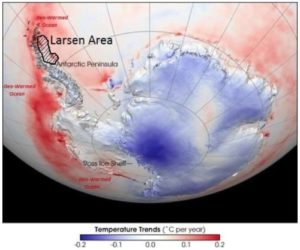by Linnaeus University, July 4, 2017
In addition to the life on the surface of the Earth and in its oceans, ecosystems have evolved deep under us in a realm coined the “deep biosphere” which stretches several kilometers down into the bedrock. Down there, the conditions are harsh and life is forced to adjust to a lifestyle that we at the surface would call extreme. One major difference to surface conditions is the lack of oxygen; a compound we take for granted and consider to be a prerequisite for survival but which subsurface life has to cope without.
Original article here (Nature Communication)
by James Kamis, July 4, 2017 in ClimateChangeDispatch
Geological heat flow is fueling bottom melting and associated cracks across West Antarctica’s Larsen Ice Shelf, having little to do with man-made global warming. Significant amounts of high-quality data and relevant geological observations support this revelation, given historical and current geological mapping efforts done in Antarctica.
 see here, image credit NASA
see here, image credit NASA
See also here (in French)
by M. Arthur et al., June 20, 2017, in Nature Communication
We show that variations in ocean temperature in the high latitude North Atlantic and Nordic Seas are reflected in the climate of northwestern Europe and in winter Arctic sea ice extent. Statistical regression models show that a significant part of northern climate variability thus can be skillfully predicted up to a decade in advance based on the state of the ocean. Particularly, we predict that Norwegian air temperature will decrease over the coming years, although staying above the long-term (1981–2010) average. Winter Arctic sea ice extent will remain low but with a general increase towards 2020.
by Sergey Kravtsov, June 15, 2017
The observed internal variability so estimated exhibits a pronounced multidecadal mode with a distinctive spatiotemporal signature, which is altogether absent in model simulations. This single mode explains a major fraction of model-data differences over the entire climate index network considered; it may reflect either biases in the models’ forced response or models’ lack of requisite internal dynamics, or a combination of both.
La géologie, une science plus que passionnante … et diverse

 see
see